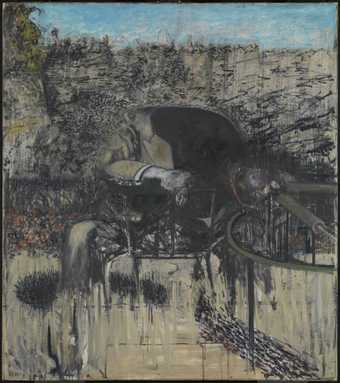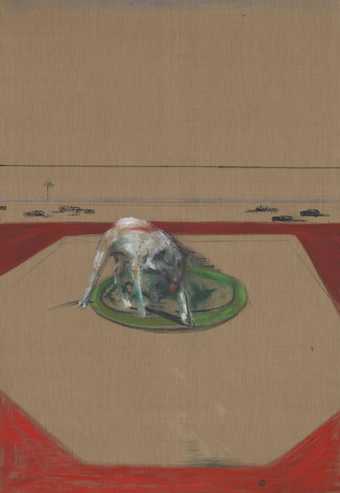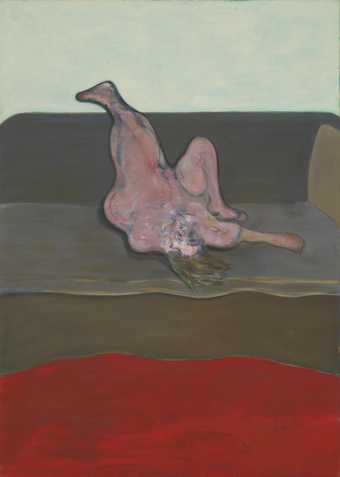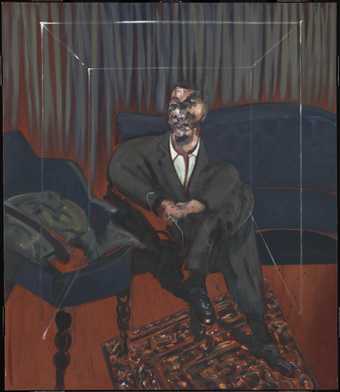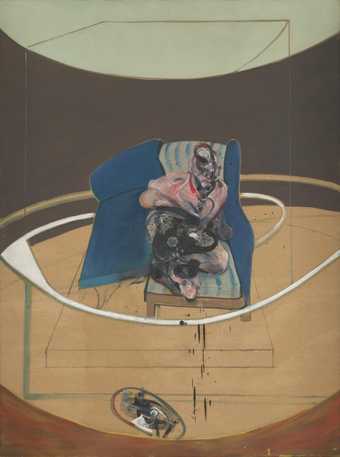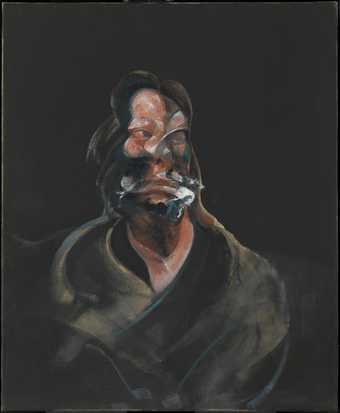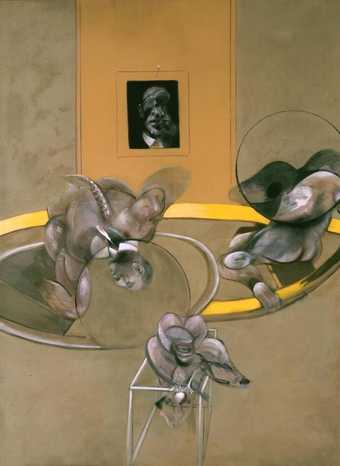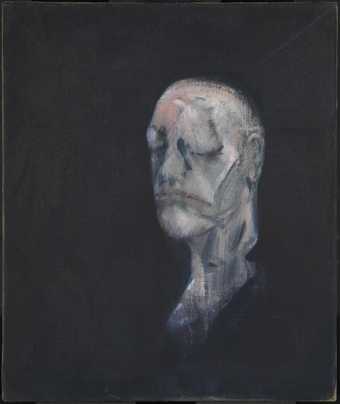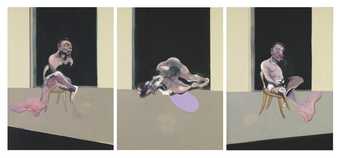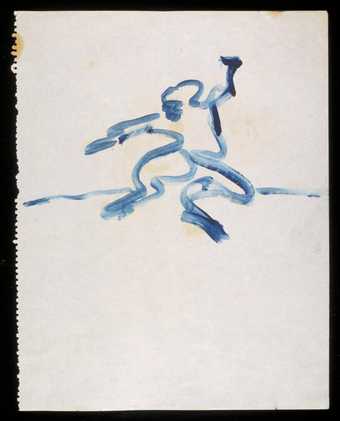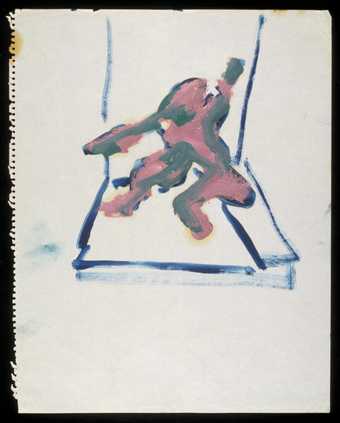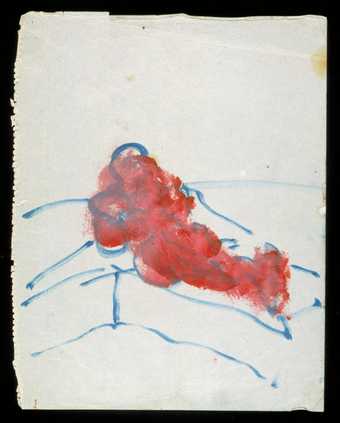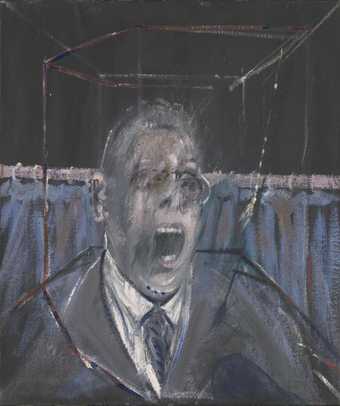
Not on display
- Artist
- Francis Bacon 1909–1992
- Medium
- Oil paint on canvas
- Dimensions
- Support: 1524 × 1168 mm
frame: 1600 × 1225 × 90 mm - Collection
- Tate
- Acquisition
- Presented by the Contemporary Art Society 1958
- Reference
- T00226
Display caption
Gallery label, September 2004
Does this text contain inaccurate information or language that you feel we should improve or change? We would like to hear from you.
Catalogue entry
Francis Bacon 1909-1992
Study for a Portrait of Van Gogh IV
1957
T00226
Oil on canvas 1524 x 1168 mm (60 x 46)
Presented by the Contemporary Art Society, 1958
Provenance:
Purchased from the artist through the Hanover Gallery, London by the R.J. Sainsbury Discretionary Fund and presented to CAS 1957
Exhibited:
Francis Bacon, Hanover Gallery, London, March-April 1957 (14)
La Peinture Britannique Contemporaine, Salle Balzac, Paris, Oct. 1957 (11)
Three Masters of Modern British Painting: Sir Matthew Smith, Victor Pasmore, Francis Bacon, Arts Council tour 1958, Victoria Art Gallery, Bath, May-June, Carlisle Art Gallery, June, Shrewsbury Art Gallery, July, Bournemouth College of Art, Aug., Manchester City Art Gallery, Aug.-Sept., Cheltenham Art Gallery, Sept.-Oct. 1958 (54, repr. pl.6)
Francis Bacon, Tate Gallery, London, May-July 1962 (60)
Henry Moore to Gilbert and George: Modern British Art from the Tate Gallery, Palais des Beaux Arts, Brussels, Sept.-Nov. 1973, as part of Europalia 73 Great Britain (75, repr. p.90)
Westkunst: Zeitgenossische Kunst seit 1939, Museen der Stadt, Cologne, May-Aug. 1981 (490, repr. pp.213, 423)
Hayward Annual 1985: A Journey through Contemporary Art with Nigel Greenwood, Hayward Gallery, London May-July 1985 (no cat. no., repr. p.3)
The Transformation of Appearances: Andrews, Auerbach, Bacon, Freud, Kossoff, Tate Gallery exhibition at Sainsbury Centre for Visual Arts, University of East Anglia, Norwich, Sept.-Dec. 1991 (17)
Francis Bacon, Louisiana Museum for Moderne Kunst, Humlebaek, Jan.-April 1998 (11, repr. in col. p.63)
Literature:
Neville Wallis, ‘Bacon and Sironi’, Observer, 24 March 1957, p.13
‘Mr Francis Bacon’s Virtuosity: Van Gogh Translated’, Times, 26 March 1957, p.3
Alan Clutton-Brock, ‘Round the London Galleries’, Listener, vol.57, no.1461, 28 March 1957, p.522
James Burr, ‘The Baconian Van Gogh: Hanover Gallery’, Art News and Review, vol.9, no.5, 30 March 1957, p.6
John Golding, ‘Lust for Death’, New Statesman and Nation, vol.53, no.1360, 6 April 1957, p.438
G.S. Whittet, ‘London Commentary’, Studio, vol.153, no.771, June 1957, p.187
Patrick Heron, ‘London’, Arts, New York, Sept. 1957, p.13
Philip James and Andrew Forge, The Arts Council Collection of Paintings and Drawings, part four: Since the War, London 1958, p.9
Lawrence Alloway, ‘Francis Bacon’, Art International, vol.4, nos. 2-3, 1960, p.63
Anita Brookner, ‘Current and Forthcoming Exhibitions: London’, Burlington Magazine, vol.104, no.712, July 1962, p.313, repr. p.315
Ronald Alley, Francis Bacon: Catalogue Raisonné and Documentation, London 1964, pp.110-111, 112, pl.131
Tate Gallery Report 1963-4, London 1964, p.17, repr. between pp.30 and 31
Mary Chamot, Dennis Farr and Martin Butlin, Tate Gallery: The Modern British Paintings, Drawings and Sculptures, I, London 1964, p.23
R.M. Dippel, ‘Van Gogh en Bacon’, Museumjournaal, April 1969, p.100, repr. p.101
Hugh M. Davies, Francis Bacon: The Early and Middle Years, 1928-1958
(Ph.D thesis, Princeton University, 1975), New York and London 1978, pp.69, 157-8, repr. pl.124
Miriam Gross, ‘Bringing Home Bacon’, Observer Review, 30 Nov. 1980, p.30
Lawrence Gowing, Francis Bacon: Paintings 1945-1982, exh. cat., National Museum of Modern Art, Tokyo 1983, p.107
Wieland Schmied, Francis Bacon: Vier Studien zu einem Porträt, Berlin 1985, pp.80-1, repr. p.79, pl.110
Jane Withers and Anthony Fawcett, ‘Carcasses and Crucifixes’, Times, 20 May 1985, p.10
Hugh Davies and Sally Yard, Francis Bacon, New York 1986, p.35
John W. Nixon, ‘Francis Bacon: Paintings 1959-1979; Opposites and Structural Rationalism’, unpublished Ph.D thesis, University of Ulster, Belfast 1986, p.576 (no.131)
Andrew Sinclair, Francis Bacon: His Life and Violent Times, London 1993, pp.131-2
David Sylvester, ‘Interviews with Francis Bacon 1962-1979’ in Francis Bacon: Paintings Since 1944, exh. cat., Tate Gallery Liverpool 1990, [pp.1-2]
Ernst van Alphen, Francis Bacon and the Loss of Self, London 1992, p.144
Bruce Bernard, Francis Bacon: Study for Portrait of Van Gogh, Arts Council brochure, London 1994, [pp.2-5], repr. in col. [p.4]
Michael Peppiatt, Francis Bacon: Anatomy of an Enigma, London 1996, pp.167-9
Carter Ratcliff, ‘Francis Bacon – An Exhibition’, Francis Bacon, exh. cat., Louisiana Museum for Moderne Kunst, Humlebaek 1998, pp.21-2 (English text)
Reproduced:
Tate Gallery Report 1958-9, London 1959, pl.3
XXe Siècle, new series, vol.22, no.15, Christmas 1960, facing p.47 (col.)
Helen Lessore, ‘A Note on the Development of Francis Bacon’s Painting’, X: A Quarterly Review, vol.2, no.1, March 1961, between pp.24 and 25
Michael Fried, ‘Francis Bacon’s Achievement’, Arts Magazine, vol.36, no.10, Sept. 1962, p.27
Norman Reid, The Tate Gallery, London 1969, p.175
Wieland Schmied, Francis Bacon: Commitment and Conflict, Munich and New York, 1996, [p.94], fig.105
Francis Bacon: Working on Paper, exh. cat., Tate Gallery, London 1999, p.17
The series of works to which Study for a Portrait of Van Gogh IV belongs signalled a dramatic shift in Francis Bacon’s technique. The lavish application of paint and the strong colouring contrasted with those employed in the preceding years. This change was acclaimed critically and was commercially successful when the second, third and fourth of the series were exhibited in March-April 1957. During the exhibition, the painter’s dealer, Erica Brausen, told a colleague that ‘they were all sold as soon as they came in’,[1]
and this was confirmed by a commentator, who wrote that ‘the pictures, some with the paint still wet on them, are selling like hot cakes’.[2]
The new paintings were made at the last moment in March to accompany works from an immediately preceding exhibition in Paris.[3]
Brausen noted that Bacon ‘kept altering the new ones’,[4]
and, in recalling getting paint on his hands when carrying one into the gallery, Bruce Bernard estimated that ‘It had perhaps been worked on only an hour previously’.[5]
He added that two further canvases arrived after the opening;[6]
Ronald Alley identifies these as Study for a Portrait of Van Gogh V and Study for a Portrait of Van Gogh VI, stating that they, too, were still wet.[7]
In his review, John Golding suggested that the exhibition confirmed Bacon’s status as the ‘most controversial and influential living English painter’.[8] He went on to characterise the artist’s ‘completely new departure’ by contrasting his earlier ‘sombre colours and ... meagre, sparing manner’ with the new paintings, which ‘are violent in colour, thickly impasted, and have obviously been painted in an intensity of excitement’.[9] Such a description is certainly applicable to Study for a Portrait of Van Gogh IV, which was one of the three canvases ready for the show’s opening. The image is established in strong primary colours painted on the reverse side of a commercially primed canvas (as was Bacon’s practice by this time). Rich blue was carried across the surface over which the white and blue-black of the figure and the red and cream of the road were worked with a palette knife; in some areas, especially bordering the side of the road, the upper layer of blue-black was scraped back to the brighter underlying colour. The orange and yellow of the background were added around the figure with heavily loaded brushes, while the yellow was drawn out in fine lines for the hat and the highlights of the trees’ branches. Although these colours appear to have been used without mixing, the layer of blue effectively muted them - it lends a greenish quality to the orange, for instance - and established a darker hue than found in the companion pieces.
Such colouring and application of paint was manifestly derived from Van Gogh’s example, just as the series took as its point of departure a colour reproduction of the Dutchman’s self-portrait The Painter on the Road to Tarascon, 1888 (destroyed in World War II, formerly Kaiser-Friedrich Museum, Magdeburg) thought to be that in Wilhelm Udhe’s monograph.[10]
Considering this use of a secondary source, Alley’s assessment that Bacon ‘changed the colours almost completely, and substituted a range of vehement reds, blues and blacks for the harmony of golden yellows, greens and browns in the original’[11]
is debatable. The colouring is stronger, but it may be linked directly to the Van Gogh, where even the rough red, yellow and blue of the road may find their source.
The handling and colouring in Study for a Portrait of Van Gogh IV was common to the two preceding works[12]
and the final work[13]
in the series of six. However, two differences should be noted: the colour of the canvas plays a significant role in these other works, and the Tate’s painting is only about three-quarters of their size.[14]
These factors set it slightly apart in impact. The two remaining paintings in the series are notably different. Study for a Portrait of Van Gogh I, 1956 (Sainsbury Collection, University of East Anglia)[15]
is hardly part of the series at all, as it was painted the year before on the smaller size support and in sombre colouring; Bacon seems to have resorted to it as a point of departure when under pressure to produce paintings for the exhibition.[16]
Study for a Portrait of Van Gogh V, 1957 (Hirshhorn Museum and Sculpture Garden, Smithsonian Institution, Washington D.C.),[17]
is not as thickly or energetically worked as its four companions and Bernard has suggested the inspiration of Edvard Munch.[18]
Two further paintings remain outside the ‘series’, presumably because they were completed after the 1957 exhibition. These are Van Gogh in a Landscape, 1957 (Centre Georges Pompidou, Paris),[19]
in which the figure is placed in the distance, and Van Gogh Going to Work, 1957 (private collection),[20]
in which the composition of the first of the series is repeated.
In The Painter on the Road to Tarascon Van Gogh created a layered depth with the figure passing across the bright horizontal foreground plane and the fields framed by roughly symmetrical trees. It is unusual as a self-portrait in setting the figure within the landscape, but an extension of the personality was transmitted in the dark accompanying shadow. In his versions, Bacon consistently made the road rise steeply to the left, and his figure - which is much larger within the composition - was shown in different places as if passing to and fro. The figure descended towards the right in Study for a Portrait of Van Gogh II, confronted the viewer in the next canvas, and headed up to the left in the Tate’s version. Taken together these recall the frozen instants of Eadweard Muybridge’s photographs (which the artist often mined for visual inspiration). As well as varying the pose, Bacon reinvented the strikingly prominent shadow of Van Gogh’s figure. His recollection of the impetus behind the series connects the shadows with death, as he told John Russell: ‘I’ve always liked early Van Gogh best, but that haunted figure on the road seemed just right at the time - like a phantom of the road, you could say.’[21]
This statement hints at his wider enthusiasm for the Dutch painter. In the cannon of modernism, Van Gogh had come to epitomise the misunderstood and ultimately tragic genius, and his myth had resonances in the post-war period in which artistic activity was frequently associated with existential doubt and isolation. That Bacon shared this view is suggested by his perception of the ‘haunted figure’ within the self-portrait. In this he was informed as much through the paintings as by the letters of Van Gogh to his brother Theo,[22]
a volume of which Bacon is said to have kept by his bed.[23]
An element of self-identification was immediately extrapolated from the series: ‘One gets the uncomfortable sensation,’ Golding remarked, ‘that in these paintings Bacon has somehow taken possession of the personality of Van Gogh and fused it with his own. As one might expect, he emphasises Van Gogh’s madness and isolation, and forces out a streak of morbidity which Van Gogh himself fought hard to suppress’.[24]
Commenting less on this portrayal, Lawrence Alloway adopted very similar language to characterise Bacon’s use of his source: ‘the metamorphosis of Van Gogh ... is precisely a taking possession of known images and personalizing them.’[25]
However, Bacon’s concentration upon the single theme resulted from a broader conjunction of concerns. It appears significant that the original painting (which he confirmed that he had not seen)[26]
- had been destroyed, as working from reproduction complied with Bacon’s preferred mitigation of reality through photography; this is a more extreme example of his contemporary inspiration from reproductions of Velazquez’s Portrait of Pope Innocent X, another painting which he never apparently saw. This distancing may have been enlivened by another source, as Golding was amongst those who noted the coincidence of the paintings with the Hollywood ‘biopic’ of the Dutch painter, Lust for Life (1956), starring Kirk Douglas.[27]
When asked about this by the Tate, the painter replied flatly: ‘all the Van Gogh series was suggested and taken from the Van Gogh painting The Road to Tarascon & not by the film at all.’[28]
Despite this, his recourse to images from popular culture makes such a connection likely and has encouraged Michael Peppiatt to assert that the film ‘quickened’ his interest in Van Gogh.[29]
Other concerns are discernible in the paintings. Bacon had spent long periods in the South of France close to Van Gogh’s motifs, and in the 1960s visited some of them with his friend the writer Stephen Spender.[30]
In the 1950s, the colour saturation may equally have been encouraged by his experience of the light in Tangier, which he visited for the first time in the autumn of 1956; he subsequently returned regularly to see his lover Peter Lacy and made several (largely unsuccessful) attempts to work there. At the same time, the handling of paint - and perhaps even the fleshy colouring - in the Van Gogh series may also be indebted to the work of Chaim Soutine, which Bacon is known to have admired and whose retrospective he may have seen in Paris in 1956.[31]
This enthusiasm was widely held among contemporaries, such as Nicholas de Stäel, and Bacon’s friends Lucian Freud and Adrian Ryan, the latter being the owner of a Soutine painting of a dissected rabbit. On the increased size of his canvases, Bacon could carry this heavily laden and gestural painting onto a grand scale which encouraged comparisons to the post-war tachisme and abstract expressionism of Karel Appel[32]
or Willem de Kooning (whose contemporary series of Women
are often cited).[33]
That this new manner was already an ambition before the Van Gogh series is indicated by the unprecedented expressionistic handling of Figure in Mountain Landscape, 1956 (Kunsthaus, Zurich).[34]
In current discourses the energy of such work was linked to an artist’s acceptance of chance effects during the process of painting - an idea expressed by Harold Rosenberg’s notion of the canvas ‘as an arena in which to act’.[35]
In this respect it is significant that Bacon later emphasised the role of accident in his use of source material - the ‘transformations of existing images’ - in his conversations with David Sylvester. In 1962 (at a time when the critic was preparing a London retrospective of Soutine),[36]
Bacon told him: ‘I foresee it [the transformed work], and yet I hardly ever carry it out as I foresee it. It transforms itself by the actual paint.’[37]
The juxtaposition of this passage with a reproduction of Study for a Portrait of Van Gogh II in Sylvester’s publication tends to imply its suitability to the rapid execution of the earlier works. At the same time, the description of such a working method closely echoed Rosenberg’s view that ‘the image would be a result of this encounter’ with the canvas.[38]
The energy of the Van Gogh series was immediately popular; the 1957 paintings were bought by public or powerful private collections, with Study for a Portrait of Van Gogh IV arriving at the Tate (via the Contemporary Art Society) through the funding of one of the painter’s most enthusiastic patrons, Robert Sainsbury. Nevertheless, dissenting critical voices were heard, and even among Bacon’s closest supporters the series came to be viewed with some reserve. The artist Patrick Heron, in admitting that he had ‘never been able to admire’ Bacon, reviewed the exhibition and contrasted the horizontal structure of Van Gogh’s painting with Bacon’s ‘slipping design’ adding: ‘It is an elementary pictorial law that a composition should feel static’.[39]
He criticised the painter for both handling and ‘horror’. More significantly, Bacon’s own move away from the energetic working of the Van Gogh series left it somewhat isolated in his oeuvre. In a witty rebuttal of Robert Melville’s existentialist interpretation of the painter’s work in 1960, Lawrence Alloway, even as he was generally supportive, was wary of the series: ‘In the Van Gogh series the paint got out of control as it flooded the surface which previously it had only grazed, like an outburst from a gypsy violin after a message in morse code.’[40]
At this stage discussion of Bacon’s work in general came to be located around the relation between figure and ground. This reflected current readings of Abstract Expressionism in the criticism of Clement Greenberg - especially through essays collected as Art and Culture[41]
- in which the integrity of the picture surface was asserted as a justification for abstract art. This climate is implicit in Bacon’s conversations with David Sylvester, which opened in 1962 with the question: ‘Have you ever had any desire at all to do an abstract painting?’[42]
and in which he acknowledged the ‘complicated stage in which painting is now’.[43]
In the same year, Michael Fried saw the ‘all-over’ handling of the Van Gogh series in Greenbergian terms as a means of integrating figure and setting.[44]
However, in a contemporary article, even Sylvester could imply reservations. He suggested that the departure of 1957 ‘related to a search for a more coherent pictorial structure’ which was characterised (in similar terms) as beginning ‘to treat the canvas as a surface, not as a tank.’[45]
In direct contrast to Fried, Sylvester considered the Van Gogh series to have failed because the figure was now ‘thrown into harsh relief by the brilliant adjacent colour [which] gives the distortions an air of wilful grotesqueness’,[46]
and this - for Sylvester - was not resolved until the 1962 triptych Three Studies for a
Crucifixion
(Solomon R. Guggenheim Museum, New York)[47]
in which these tendencies were reconciled with the ‘sculptural character’ of Three Studies for Figures at the Base of Crucifixion (Tate Gallery N06171). Thirty years later, the critic remained convinced enough of this assessment to restate it (quoting himself).[48]
The understanding of the Van Gogh series as a watershed in Bacon’s career has become commonplace. It is taken up by Ernst van Alphen, who fixed upon the relation of figure to landscape as unique for the painter, proposing that Bacon ‘makes the space which surrounds Van Gogh ... into a metaphor for the body’.[49]
Citing the roads in the third and fourth canvases as having ‘the rawness of decomposing meat’, he suggested that ‘Van Gogh’s deathly appearance is stressed, perhaps even caused, by the bodily landscape ... the landscape is in fact a bodyscape’.[50]
Other commentators have passed over the series more cursorily. Thus Michel Leiris called it (and the Popes) ‘anachronistic up to a point’ when he designated Bacon’s paintings in general as the ‘immediate expression of something immediate’.[51]
For his part, Gilles Deleuze was willing to treat them as integral to the oeuvre. He saw the works partly in relation to Bacon’s approach to the capturing of movement of the figure (which Deleuze compared to a daily ‘petit tour’)[52]
and partly as ‘Figures-paysages’, exemplary of a formal separation of brushwork from narrative function, gesture from signification.[53]
That it has remained unusual not to distinguish the Van Gogh series from the rest of the Bacon’s work, reflects an isolation which the painter himself encouraged both in passing little comment on the works and in never resuming this ‘all-over’ gestural paint-work which singled them out.
Matthew Gale
February 1999
[2] John Golding, ‘Lust for Death’, New Statesman and Nation, vol.53, no.136, 6 April 1957, p.438
[3] Francis Bacon, Galerie Rive Gauche, Paris, Feb.-March 1957
[4] Brausen, letter to Dix, 1 April 1957, Tate Gallery Archive 863
[5] Bruce Bernard, Francis Bacon: Study for Portrait of Van Gogh, Arts Council brochure, London 1994, [p.2]
[6] Ibid., [p.3]
[7] Ronald Alley, Francis Bacon: Catalogue Raisonné and Documentation, London 1964, pp.110-111
[11] Alley 1964, p.111
[13] Study for a Portrait of Van Gogh VI, 1957, Arts Council Collection, repr. Francis Bacon, exh. cat., Tate Gallery, London 1985 [p.67], no.37 (col)
[14] All the others measure 1980 x 1420 mm
[15] Repr. Bernard 1994, [p.2], (col.)
[16] Ibid., [p.3]
[17] Repr. Francis Bacon, exh. cat., Louisiana Museum for Moderne Kunst, Humlebaek 1998, p12, repr. in col. p.65 (col.)
[23] John Rothenstein, ‘Introduction’ in Alley 1964, p.18
[24] Golding 1957
[25] Lawrence Alloway, ‘Art News from London’, Art News, vol.54, May 1957, p.57, quoted in Hugh M. Davies, Francis Bacon: The Early and Middle Years, 1928-1958 (Ph.D thesis, Princeton University, 1975), New York and London 1978, p.159
[27] Golding 1957
[28] Bacon, letter to the Tate Gallery [9 Jan. 1959], Tate Gallery cataloguing files, cited in Mary Chamot, Dennis Farr and Martin Butlin, Tate Gallery: The Modern British Paintings, Drawings and Sculptures, I, London 1964, p.23
[29] Michael Peppiatt, Francis Bacon: Anatomy of an Enigma, London 1996, p.168
[31] Soutine 1894-1943, Maison de la Pensée Francaise, Paris, March- April 1956
[32] Davies 1978, p.161
[33] Ibid., and Lawrence Alloway, ‘Francis Bacon’, Art International, vol.4, nos.2-3, 1960, p.63
[34] Repr. Francis Bacon, exh. cat., Centre Georges Pompidou, Paris 1996, p.128, no.32 (col.)
[36] Soutine, Arts Council exhibition at Tate Gallery, London, Sept.-Nov. 1963
[37] David Sylvester, Interviews with Francis Bacon, London 1975, revised as The Brutality of Fact: Interviews with Francis Bacon, 1980, 3rd ed. 1990, 4th ed. as Interviews with Francis Bacon, 1993, p.16
[38] Rosenberg 1962, p.25
[40] Lawrence Alloway, ‘Dr. No’s Bacon’, Art News and Review, vol.12, no.6, 9-23 April 9-23, p.4
[42] Sylvester 1993, p.8
[43] Ibid., p.22
[44] Michael Fried, ‘Bacon’s Achievement’, Arts, vol.36, no.10, Sept. 1962, pp.28-9
[45] David Sylvester, ‘Francis Bacon’, New Statesman, vol.53, no.1632, 22 June 1962, p.915
[46] Ibid. p.916
[47] Repr. Alley 1964, pp.144-5, no.201 (col.)
[48] David Sylvester, ‘Bacon’s Course’ in Achille Bonito Oliva (ed.), Francis Bacon: Figurabile, exh. cat., Museo Correr, Venice 1993, p.52
[50] Ibid.
[51] Michel Leiris, Francis Bacon, face et profil, Paris, Munich and Milan 1983, trans. John Weightman as Francis Bacon: Full Face and in Profile, Oxford 1983, p.17
[52] Gilles Deleuze, Francis Bacon: logique de la sensation, Paris 1981, p.30
[53] Ibid. p.11
Explore
- architecture(30,960)
-
- townscapes / man-made features(21,603)
-
- road(1,228)
- emotions and human qualities(5,345)
- clothing and personal items(5,879)
-
- cane / walking stick(118)
- hat(1,437)
- actions: postures and motions(9,111)
-
- bending forward(353)
- walking(607)
- man(10,453)
- individuals: male(1,841)
- arts and entertainment(7,210)
-
- artist, painter(2,545)
You might like
-
Francis Bacon Figure in a Landscape
1945 -
Francis Bacon Dog
1952 -
Francis Bacon Three Studies for Figures at the Base of a Crucifixion
1944 -
Francis Bacon Reclining Woman
1961 -
Francis Bacon Seated Figure
1961 -
Francis Bacon Study for Portrait on Folding Bed
1963 -
Francis Bacon Portrait of Isabel Rawsthorne
1966 -
Francis Bacon Three Figures and Portrait
1975 -
Francis Bacon Study for Portrait II (after the Life Mask of William Blake)
1955 -
Francis Bacon Triptych August 1972
1972 -
Francis Bacon Sketch [Figure with Left Arm Raised, No. 1]
c.1959–61 -
Francis Bacon Sketch [Figure with Left Arm Raised, No. 2]
c.1959–61 -
Francis Bacon Sketch [Head]
c.1959–61 -
Francis Bacon Sketch [Figure Lying, No. 1]
c.1959–61 -
Francis Bacon Study for a Portrait
1952

